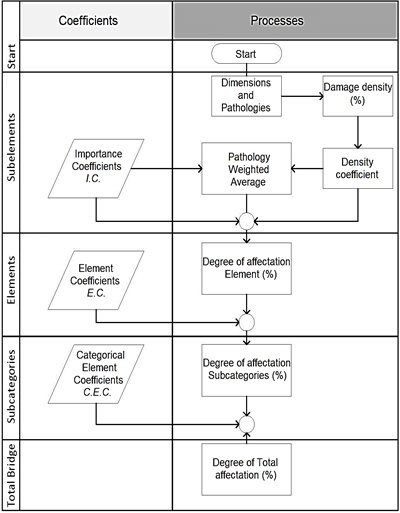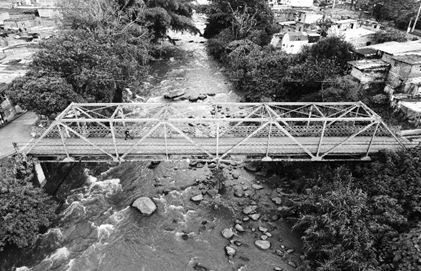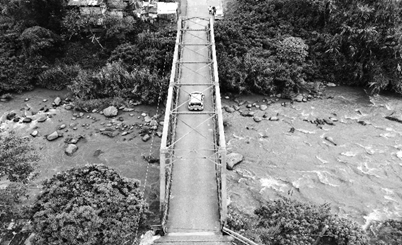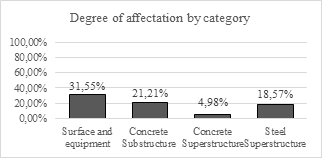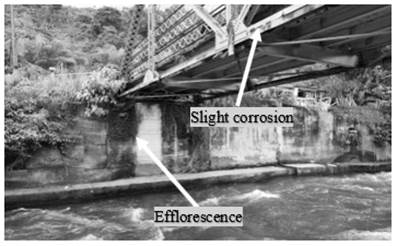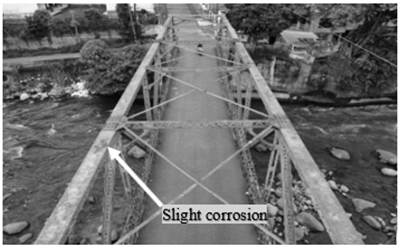1. Introduction
The socioeconomic development of a country is directly related to the optimal functioning of the transport infrastructure. Bridges are structures that influence the continuity of the road system service. Therefore, the health of these structures depends on inspection tasks focused on detecting damage to make subsequent recommendations, considering that deterioration is expected due to a lack of adequate maintenance. When a bridge is in a critical state regarding structural stability and load capacity, traffic safety in the area is at risk; for this reason, inspection activities generate risk mitigation and avoid catastrophes. Invías is the government organization responsible for managing the Colombian national highway system; therefore, it develops maintenance, rehabilitation, and conservation activities for the different bridges in the national road network. Also, the constant monitoring to guarantee good structural health, optimize the useful life and continuity of the service of the bridges.
In the general case of bridges, they are structures exposed to climatic effects, and they are highly susceptible to deterioration caused by the surrounding environmental conditions. Due to the above, different methodologies have currently been proposed to evaluate their condition. These techniques are based on the characteristics of the materials, structural typology, and resistance criteria that allow them to be analyzed through models applied in the inspection [1-5]. Nonetheless, constant monitoring and evaluation of the structural response of the bridge using these methodologies are required to avoid future catastrophes [6-10]. Based on the diverse techniques that exist to determine the state of bridges, it is possible to generate predictions that allow recognizing the level of deterioration based on the existing damage pathology [11-14].
Then, new solution alternatives have been generated for the inspection where multiple methodologies are implemented; some as application methods based on big data to detect the dynamics of the structure and establish load test models [15,16]. Other methods relate data collected in the inspection and directly diagnose structural vulnerability [17]. In addition, some approaches allow modeling and predicting the decrease in the capacity of beams in bridges [18]. In the same way, non-contact crack detection techniques based on images are proposed to determine the affectation in the resistance parameters [19]. All these new alternatives have the same objective: to determine the vulnerability value of the existing bridges exposed to the environment to apply reinforcement alternatives [20].
Deterioration assessment processes are essential to take control of bridges and determine the appropriate maintenance plans to mitigate existing failures [21,22]. Some of the most relevant pathologies in an inspection study are cracks because they cause a reduction in the section and resistance of the bridge, damaging the structural elements and causing a limitation of the load capacity. The effect of hydrological and hydraulic factors must also be evaluated. Depending on the flow conditions of the river that the bridge crosses, deterioration mechanisms or failure can be predicted, such as loss of support material in the foundation and overturning phenomena that generate the collapse of the structure [23-27].
The inspection is an activity with a high degree of complexity that must be carried out in an organized and systematic way, whereas the perception of deterioration and the preventive or corrective actions to be taken depend on it. However, the current technological progress in engineering allows for effectively mitigating and solving obstacles, limitations, and error generators. These technologies have provided multiple electronic devices that support monitoring tasks, such as the assistance of drones that allow data collection and photographic recording [28-32]. Consequently, through the development of applications and software, the registry of visual defects for quality control is consolidated, which allows the user to automate the results and speed up the investigative development [33-44], these applications have modeling capabilities to facilitate analysis. Based on the same technologies, monitoring systems are established that allow the constant study of the structure and an identification of the location of the damage in space [45-48].
Consequently, the intrinsic advantages of the visual inspection methodology to study the deterioration of bridges are highlighted, mentioning that it is possible to evaluate bridges in service, remaining intact and open to the public during the inspection period [49]; besides, the possibility of being complemented with other methodologies such as PCI (Pavement Condition Index), consisting of a numerical index used to indicate the general condition of a pavement structure. The PCI is widely used in transportation engineering and many municipalities use it to measure road infrastructure performance and service levels. Therefore, it increases the level of detail in the bridge inspection process. [50]. Nevertheless, there are uncertainties surrounding the visual inspection methodology when it is required to establish the frequency of work inspection of the structure since some studies suggest that bridge inspection standards for the United States, for example, require routine visual inspections, regardless of the condition of the bridge [51]. Furthermore, another question regarding visual inspection is oriented to the sufficiency to evaluate the damages in a bridge because these are carried out to guarantee the safe operation, and estimate the useful life of the structure [52]. Nonetheless, the results obtained in inspections related to this methodology are qualitative, producing subjective analyzes according to the personal criteria of the supervisor.
In contrast to the above, when more objective results are required, a quantitative study should be generated in which the inspections are more detailed as was done in the study [53], which states that the aggressiveness of the environment does not only damage structures but also affect the level of the stress state of the structural elements, generating objective results related to the degree of quantitative affectation. A similar option to generate objectivity of the results can be obtained with dynamic studies that allow identifying all bridge damage [54]. This way, using modal parameters, time series, and different mathematical formulations, generates a better study detail than the primary visual inspection.
Although there are more detailed analyzes than visual inspections, these require more time and hardware resources. Therefore, there are alternatives to quantify said damage without having to carry out mathematical formulations that can sometimes be complex. These alternatives are based on qualitative data and results; despite geometrical comparison models, results can be obtained that quantify the damage produced [55,56].
In spite of technological advances, the visual inspection methodology is the primary tool for data collection in bridge structures, regardless of the limited level of detail in the results.
As a consequence of the above, a methodological procedure is presented for quantifying the structural deterioration of bridges based on visual inspection, improving the procedures designated in the Manual of visual inspection of bridges and pontoons of Invías [57]. Furthermore, assigning values of importance to the elements of the bridge and the pathologies detected, obtaining degrees of quantitative affectation for all the categories designated Manual, as they are: surface and equipment, substructure, concrete superstructure, and metallic superstructure.
2. Methodology
The parameters and criteria used in the generation of the methodology for quantifying structural deterioration of bridges are presented, allowing to increase the objectivity of the inspection results through analysis with quantitative criteria. Notwithstanding, the starting point is the qualitative methodology in the Invías Manual [57]. In such a way, the technical composition is achieved through the additional support of the PCI methodology, where rating ranges are obtained [58].
The methodological process is shown in Fig. 1; it consists of four general stages: sub-elements, elements, subcategories, and total bridge. First, it is necessary to measure the Sub-elements of the bridge and the deterioration pathologies evidenced in them, allowing to determine the density of damage that represents the severity of each pathology in a coefficient. Next, the weighted average is calculated for each pathology based on the determined density coefficients and Importance Coefficients (I.C.) defined for each Sub-element.
Second, the degree of affectation of each element of the bridge is determined, and obtained from the integration of the weighted averages calculated previously.
Third, the degree of affectation of each Sub-category is calculated based on previous stages, besides the effect caused by categorizing the importance of the elements through the Element Coefficient (E.C.).
In the fourth stage, the degree of total affectation of the bridge is determined as a result of quantification of the contribution of each deterioration determined in the previous stages for each Sub-category affected by the Categorical Element Coefficients (C.E.C.).
2.1. Damage pathology density calculation procedure
The initial procedure is the identification of the sub-elements belonging to each element, and through visual inspection, the associated damage pathologies are detected, as shown in Table 6. Then, the total dimension measurements of the sub-elements and the deterioration of the measurement in the same sub-elements. This way, it is possible to quantify the damage density for each pathology identified with Eq. 1.
With the calculated damage pathology density, it is possible to define the density coefficient (D.C.) based on severity ranges that allow the affectations to be classified as low, medium, or high (1, 2, and 3, respectively) for the Sub Elements, the values mentioned are proposed in Table 6. The selection criteria of the severity ranges for the definition of the D.C. obeys the importance and degree of vulnerability generated in the entire structure in case of failure of the Sub Element.
2.2. Proposed importance coefficients for sub elements
Then, the importance coefficients (I.C.) are proposed, as shown in Table 1, with a variation on a scale from 1 to 5. These coefficients depend on the priority of each element for the optimal general behavior of the structure and the influence it has on adjacent structures. An example of the above is the effects on drainage; according to the visual inspection manual of bridges and pontoons of Invías, three types of pathology can be identified (plugged, absence, and insufficient drainage length), and each one of them has an I.C. different. Consequently, the most important is the absence of drains with a value of 5, because, in case of blockage or insufficient length, the adverse effects can be corrected with maintenance activities, but in the case of absence, there is a high probability of presenting filtration problems to other elements of the structure, such as the slab, beams, and supports. Therefore, it is highly probable that other types of more severe pathologies will be triggered.
Table 1 Values of Importance Coefficient (I.C.) for each Sub Element of the bridge.
| Element | Sub Element | I.C. |
|---|---|---|
| Expansion joints | Sealant | 4 |
| Profile | 2 | |
| Corner guard | 2 | |
| Platforms / kerbstone | Corner chipping | 2 |
| Exposed steel | 3 | |
| Insufficient dimensions | 3 | |
| Railings | Paint | 1 |
| Poles | 2 | |
| Railing | 3 | |
| Signaling | Horizontal | 2 |
| Vertical | 3 | |
| Reducers | 1 | |
| Drainage | Plugged | 2 |
| Absence | 5 | |
| Insufficient length | 3 | |
| Concrete structures | Design | 3 |
| Construction | 4 | |
| Operation | 2 | |
| Steel arches | Arch left and right | 4 |
| Lateral bracing | 2 | |
| Steel profiles | Beams | 4 |
| Stringer | 3 | |
| Diaphragms | 2 | |
| Steel trusses | Steel cords | 3 |
| Steel uprights | 4 | |
| Steel diagonals | 2 | |
| Steel connections | Welding | 4 |
| Steel connectors | 2 | |
| Steel pins | 1 | |
| Cables/ Struts/Towers | Cables | 3 |
| Struts | 4 | |
| Towers | 2 |
Source: Authors, 2022.
2.3. Degree of affectation of each element calculation procedure
Obtained the Density Coefficients for each evidenced pathology and the Importance Coefficients for each sub-element, the weighted average (W.A.P.) of each registered pathology is calculated as shown in Eq. 2. Then, the Degree of Affectation of each Element (D.A.E. %) is calculated as shown in Eq. 3, where the sum of all the weighted averages of pathologies of each element must be considered and related to the coefficients D.C., and the coefficients I.C. of each pathology.
2.4. Degree of affectation of each subcategory calculation procedure
Consequently, the Degree of Affectation for each Subcategory (DASC%) is determined as shown in Eq. 4, where an Element Coefficient (E.C.) is assigned to each element. The influence criterion is considered in the general structure, a similar case for obtaining the I.C. The proposed values are presented in Table 2. Additionally, the Degree of Affectation of each Element (DAE%) is considered.
Table 2 Element Coefficient (E.C.) Values for each Element
| Subcategory | E.C. |
|---|---|
| Expansion joints | 3 |
| Platforms / kerbstone | 1 |
| Railings | 2 |
| Signaling | 2 |
| Drainage | 4 |
| Bridge fins | 4 |
| Bridge abutments | 4 |
| Pillars | 2 |
| Slab | 3 |
| Beams | 5 |
| Strut | 3 |
| Bridge supports | 5 |
| Concrete arches | 5 |
| Steel arches | 5 |
| Steel profiles | 4 |
| Steel Trusses | 4 |
| Steel connections | 5 |
| Cables/ Struts/Towers | 3 |
Source: Authors, 2022.
2.5. Degree of total affectation of the bridge calculation procedure
Subsequently, the Degree of Total Affectation of the bridge (DTA%) is calculated as evidenced in Equation 5, based on the weighted average methodology, for which the Categorical Element Coefficient (C.E.C.) is proposed, with similar criteria to those previously described for other coefficients as presented in Table 3.
2.6. Representation of the level of deterioration
Finally, according to the Degree of Total Affectation of the bridge (DTA%) obtained by applying the WABIM methodology, comments related to the condition of the structure and maintenance recommendations are presented, increasing the objectivity of the analysis represented in the level of risk for the users. Therefore, the percentage ranges of total affectation, analysis, and recommendations are presented in Table 4.
Table 4 Affectation degree ranges
| Ranges | Bridge condition | Recommendation | |
|---|---|---|---|
| 0% | 10% | No deterioration | Schedule long-term maintenance |
| 10.1% | 40% | Low deterioration | Schedule maintenance |
| 40.1% | 50% | Moderate deterioration | Schedule short-term maintenance |
| 50.1% | 90% | Medium-high deterioration | Schedule immediate maintenance |
| 90.1% | 100% | High deterioration Susceptible to collapse | Maximum risk state - Close the use of the structure |
Source: Authors, 2022.
When there is a value of DTA% between 0% and 10%, it is considered without deterioration. Therefore, long-term preventive maintenance programming is recommended. On the contrary, when the total deterioration values are between 10.1% and 40%, it is considered a low level of deterioration; a preventive maintenance intervention is necessary for the medium term, and some corrective maintenance activities may be necessary for the bridge. When a DTA% value between 40.1% and 50% is evidenced, it is considered moderate damage to the bridge. Consequently, it shows the short-term need for corrective and preventive maintenance.
Accordingly, when bridge deterioration values between 50.1% and 80% are present, the analysis must consider an immediate intervention of the structure through mainly corrective maintenance; it is considered a medium-high deterioration. Finally, when a DTA% value between 80.1% and 100% is presented, it is necessary to declare the structure in a maximum risk state due to its high deterioration with susceptibility to bridge collapse. Therefore, the immediate recommendation is the closure of the service.
3. Application case of the WABIM methodology
The result of the practical application exercise of the WABIM methodology is presented for La Esneda bridge in the 24th street Pereira, Risaralda - Colombia. The longitudinal and transversal structural typology is presented in Fig. 2 and Fig. 3; also, the general data of the structure is presented in Table 5.
Table 5 General data of La Esneda bridge
| General data | |
|---|---|
| Bridge length | 42 m |
| Bridge width | 4.80 m |
| Material | Steel frame with concrete slab |
| Bridge gauge | 5.30 m |
| Obstacle that saves | Otún River |
| Bridge type (Transverse structure) | Code 5 Underpass Warren Truss |
| Bridge type (Longitudinal structure) | Code 1: Simply supported steel beams |
| Surface type | Concrete - Code 02 |
| Geographical coordinates | 4.491659 N, -75.41528 E |
Source: Authors, 2022.
3.1. Qualitative analysis
Esneda bridge has two reinforced concrete abutments in good structural condition; however, there is biological contamination of the concrete generated by excessive vegetation, and there is no evidence of deterioration of the abutments due to the action of the river flow. The bridge's pavement is rigid (hydraulic concrete) without showing any visual pathology of deterioration; also, the expansion joints are in good condition. The bridge does not have signs or lighting, the structure does not have a pedestrian zone, and the passage is restricted to heavy vehicles.
The structural configuration of the bridge consists of warren-type steel trusses. The lower chord is made of W-type beams; the uprights and diagonals of each truss and the lateral bracing are made of simple and double-angle-type steel profiles. Additionally, the upper chord of the bridge is made of elements joined by steel rivets that form a box-type section. All connections are made with plates using steel rivets. Moreover, the bridge deck is a hydraulic concrete slab supported by a framework of W-type steel beams.
Table 6 Ranges for definition of Density Coefficient D.C. for each type of pathology.
| Sub Category / Element | Sub Element | Low | Medium | High | |
|---|---|---|---|---|---|
| Surface and equipment | Expansion joints | Sealant | Less than 5% | 5%-25% | Greater than 25% |
| Profile | Less than 20% | 20%-50% | Greater than 50% | ||
| Less than 3% | 3%-7% | Greater than 7% | |||
| Corner guard | Less than 15% | 15%-30% | Greater than 30% | ||
| Platforms / kerbstone | Corner chipping | Less than 15% | 15%-30% | Greater than 30% | |
| Exposed steel | Less than 15% | 15%-30% | Greater than 30% | ||
| Insufficient dimensions | Less than 30% | 30%-60% | Greater than 60% | ||
| Railings | Paint | Less than 30% | 30%-60% | Greater than 60% | |
| Poles | Less than 30% | 30%-60% | Greater than 60% | ||
| Railing | Less than 20% | 20%-40% | Greater than 40% | ||
| Signaling | Horizontal | Less than 20% | 20%-40% | Greater than 40% | |
| Vertical | Less than 20% | 20%-40% | Greater than 40% | ||
| Reducers | Less than 20% | 20%-40% | Greater than 40% | ||
| Drainage | Plugged | Less than 15% | 15%-30% | Greater than 30% | |
| Absence | Less than 15% | 15%-30% | Greater than 30% | ||
| Insufficient length | Less than 15% | 15%-30% | Greater than 30% | ||
| Concrete substructure and superstructure | Design | AL, AL, VO | Less than 15% | 15%-30% | Greater than 30% |
| FIF, F.I.C., F.I.T. | Less than 10% | 10%-30% | Greater than 30% | ||
| Construction | S.E., H.O., F.I.R., J.F., RE, E.X.A. | Less than 5% | 5%-25% | Greater than 25% | |
| Operation | IN, E.F., C.A.R., C.O.A., C.T.C., I.M.P., S.O.C. | Less than 20% | 20%-50% | Greater than 50% | |
| Steel superstructure | Steel arches, Steel profiles, Steel trusses | COL-COM-COS-PI-PGL-DX | Less than 15% | 15%-30% | Greater than 30% |
| FIV | Less than 10% | 10%-30% | Greater than 30% | ||
| I.M.P. | Less than 20% | 20%-40% | Greater than 40% | ||
| Steel connections | A.U.C., EX, T.P., A.P., DG, CT, B.Q., S.O.L. | Less than 20% | 20%-40% | Greater than 40% | |
| Cables/ Struts/Towers | P.R.C., T.E.C., F.I.A., F.I.M., C.T.A. | Less than 10% | 10%-30% | Greater than 30% | |
| P.L., PGL, FIV, DX | Less than 20% | 20%-40% | Greater than 40% | ||
Source: Authors, 2022.
Some of the deterioration detected in terms of the steel structure elements is the deterioration of paint. It becomes a slight corrosion phenomenon in specific areas of the upper chord. On the other hand, in the elements of the concrete substructure, there is evidence of biological contamination of the concrete and efflorescence in a large part of the abutments.
3.2. WABIM methodology analysis
Starting from the qualitative methodology contained in the Manual of visual inspection of bridges and pontoons of Invías, the WABIM methodology was applied to the La Esneda bridge structure, allowing the generation of objective analysis and recommendations based on the deterioration measurement results of all the elements of the bridge presented in Fig. 4.
The category with the highest degree of affectation was that of surface and equipment with 31.55%; many specific areas of the railings show slight corrosion and paint detachment. Additionally, the bridge does not have signage or lighting. These deteriorations occur due to exposure to environmental conditions and lack of structural maintenance.
The substructure has 21.21% efflorescence due to the vegetation that the concrete abutments present, as shown in Fig. 5, which can cause significant damage in the future at the integral level of the structural reinforcing steel and the physicochemical composition of the concrete. Nevertheless, the integrity of the abutments has not been severely affected.
Efflorescence does not constitute a problem of durability of the structures; though, it affects the aesthetics and causes an increase in the porosity of the concrete and an increase in permeability, increasing the vulnerability of the concrete to other pathologies deteriorate the structure.
The concrete superstructure has a 4.98% impact on the slab due to some contaminated areas efflorescence on the sides. This agent is due to the high humidity in the area and lack of maintenance on the bridge. The steel superstructure has 18.57% damage, and the lower chords and the diagonals have slight corrosion, as shown in Fig. 6.
According to the results of DTA% shown in Table 7, the bridge presents low deterioration, for which it is recommended to schedule maintenance with activities focused on the installation of signage, lighting, and painting to avoid the progression of more serious pathologies, severe in steel elements. Cleaning and waterproofing of the concrete substructure are also necessary to prevent future damage to the steel-reinforced concrete elements.
4. Conclusion
The WABIM methodology based on visual inspection for the quantification of bridge damage was presented, as well as a case of practical application. Therefore, the additional value of weighting the numerical results is generated.
A high degree of inefficiency in the different perspectives applied to the analysis of the results is identified in the procedures that consist only of visual inspection, having a subjective approach; hence, through the WABIM methodology, it is possible to describe qualitative results quantitatively, increasing the objectivity of the final analyzes that support decision-making related to maintenance planning. Furthermore, allowing the implementation of individual analyzes of each affectation experimentally, managing to optimize the general qualification values as occurs in the PCI methodology. consequently, there is still a degree of subjectivity in the results; however, the proposed WABIM methodology improves the objectivity of bridge damage.
The use of drones (UAV) and other technology facilitate the collection of data from the bridge since sometimes access can be difficult. Additionally, it is proposed to implement this methodology in other countries to make a comparison of the bridge standards of other countries.














